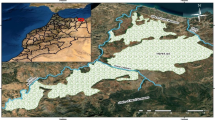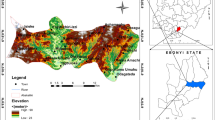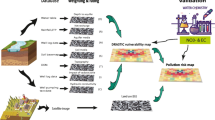Abstract
Knowledge of spatial and temporal variability in groundwater quality is necessary to validate and compliment aquifer vulnerability estimates that have become important elements for sound resources planning. Here, to evaluate vulnerability of the unconfined groundwater, we assessed intrinsic aquifer vulnerability of the alluvial Nasuno Basin of Tochigi Prefecture, Japan, using the DRASTIC model. We also used a groundwater quality index, which synthesizes different available water quality data to delineate spatial variability in the overall groundwater quality. Data are mapped spatially in GIS (Geographic Information System) and the results integrated to assess the pollution risk and degree of sustainability of water quality in the basin. Although the study area was characterized by high to very high aquifer vulnerability, the groundwater quality was generally good with only limited zones showing relatively lower groundwater quality: the vicinity of the Naka and Houki Rivers and the lower part of the basin. This information clearly reflects the greater role of anthropogenic impacts (agricultural and urban activities) on the groundwater quality of the area.
Access this chapter
Tax calculation will be finalised at checkout
Purchases are for personal use only
Similar content being viewed by others
References
Aller L, Bennet T, Leher JH, Petty RJ, Hackett G (1987) DRASTIC: a standardized system for evaluating ground water pollution potential using hydrogeological settings. EPA 600/2-87-035. Environmental Protection Agency, Washington, DC
Babiker IS, Mohamed MAA, Hiyama T (2007) Assessing groundwater quality using GIS. Water Resour Manag 21:699–715
Cavallin A, Giuliano G (1992) A procedure for evaluating aquifer vulnerability on a regional scale using computerized systems: a case study. ITC J 2:154–158
Choi MW (1976) A hydrological study of the groundwater in Nasu. Tochigi Prefecture. Ph.D. dissertation. The Tokyo Press, Tokyo, pp 21–39
Civita MV (1994) Le carte della vulnerabilita ‘degli acquiferi all’ inquinamento. Teoria and practica. Pitagora, Bologna (in Italian)
Evans BM, Myers WL (1990) A GIS-based approach to evaluating regional groundwater pollution potential with DRASTIC. J Soil Water Conserv 45:242–245
Hiyama T, Suzuki Y (1991) Groundwater in the Nasuno Basin: spatial and seasonal changes in water quality. Hydrology (J Jpn Assoc Hydrol Sci) 21:143–154 (in Japanese)
ITC-ILWIS (2001) Ilwis 3.0. Academic user’s guide. International Institute for Aerospace Survey and Earth Sciences (ITC), The Netherlands, pp 428–456
Melloul A, Collin M (1994) Water quality factor identification by the ‘Principal Components’ statistical method. Water Sci Techno 34:41–50
Ohashi M, Tase N, Hiyama T, Suzuki Y (1994) Temporal and spatial changes of nitrate concentration of groundwater in the Nasuno Basin. Hydrology (J Jpn Assoc Hydrol Sci) 24:221–232 (in Japanese)
Robins NS (2002) Groundwater quality in Scotland: major ion chemistry of the key groundwater bodies. Sci Total Environ 294:41–56
Rosen L (1994) A study of the DRASTIC methodology with emphasis on Swedish conditions. Ground Water 32:278–285
Thornthwaite CW (1948) An approach toward a rational classification of climate. Geogr Rev 38:55–94
Wakui H, Yamanaka T (2006) Sources of groundwater recharge and their local differences in the central part of Nasu fan as revealed by stable isotopes. J Groundw Hydrol 48:263–277 (in Japanese)
World Health Organization (WHO) (2004) Guidelines for drinking-water quality, vol 1, 3rd edn. Recommendations. WHO, Geneva, pp 145–220
Acknowledgments
This research was funded by the Japan Society for the Promotion of Science (JSPS). We therefore express our sincere gratitude and appreciation for the unlimited financial and logistic support.
Author information
Authors and Affiliations
Corresponding author
Editor information
Editors and Affiliations
Rights and permissions
Copyright information
© 2014 Springer Japan
About this chapter
Cite this chapter
Hiyama, T., Babiker, I.S., Mohamed, M.A.A. (2014). Evaluation of Groundwater Vulnerability and Sustainability Using GIS. In: Taniguchi, M., Hiyama, T. (eds) Groundwater as a Key for Adaptation to Changing Climate and Society. Global Environmental Studies. Springer, Tokyo. https://doi.org/10.1007/978-4-431-54968-0_7
Download citation
DOI: https://doi.org/10.1007/978-4-431-54968-0_7
Published:
Publisher Name: Springer, Tokyo
Print ISBN: 978-4-431-54967-3
Online ISBN: 978-4-431-54968-0
eBook Packages: Earth and Environmental ScienceEarth and Environmental Science (R0)




